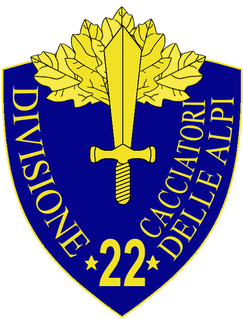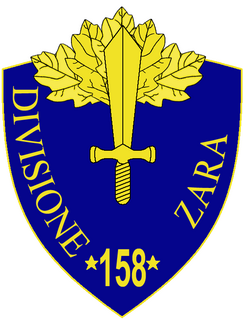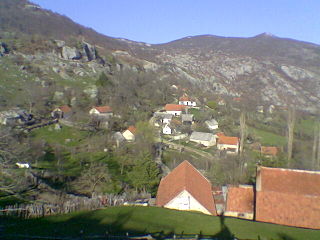History
10 June 1940, the Marche division was transferred to Treviso. In the March, 1941, the division was assigned to Italian XVII (Armoured) Corps and was sent to the Potenza-Eboli-Padula on the south of Italy to reinforce a coastal defence.
But before the move was completed, in the 1–10 April 1941 interval, the Marche division was rerouted to Albania due to the collapse of the Greek resistance in the Greco-Italian War. Initially, the division was garrisoned on the Yugoslavia-Albania border at Shkodër-Lezhë-Koplik area. It crossed the border with Yugoslavia 20 April 1941 as part of Invasion of Yugoslavia, and proceed to capture Dubrovnik, Trebinje, Bileća, Metković, Mostar, and islands of Mljet and Korčula. Afterward, the division was tasked with coastal defence and anti-partisan actions.
The initial fighting with Yugoslav Partisans started in July, 1941, near Gacko. In this period the Giuseppe Amico had assumed the post of division commander instead of Riccardo Pentimalli. The change of the command was the immediate result of division capturing the main Yugoslavian gold reserve, a total of 56 tons of gold bars and coins, hidden in a cave. On 30 July 1941, fighting escalated at Dragalj-Grahovo, Nikšić in a joint anti-partisan action with a 48th Infantry Division Taro and a 22nd Infantry Division Cacciatori delle Alpi. In September 1941, partisan raids on Gacko became so severe that the Marche division was forced to garrison Gacko permanently. As local partisan activity diminished, the division performed a series of patrols and skirmishes on the Serbia-Croatia border from 9 October 1941 to 9 November 1941. Heavy fighting for the control of the Trebinje-Bileća road happened from 5 December 1941 to 20 December 1941, and ended with a victory for the Marche division. In the same period, the division repulsed partisan attacks on the city of Dubrovnik and the Gabela-Dubrovnik-Kotor railroad.
From January 1942 to May 1942, the intensity of skirmishes with Yugoslav Partisans in the Bileća-Gacko-Trebinje region increased gradually. In June, 1942, a major mopping-up operation started in the Dobromani-Lastva-Plana, Bileća area. Especially heavy fighting happened at Plana, Bileća, which was initially firmly under Yugoslav Partisan control. Later, the focus of fighting shifted back to the Gabela-Dubrovnik-Kotor railroad.
The Division was in the Axis order of battle during the Battle of the Neretva (Operation Weiss) between 20 January and 17 February 1943 and in Battle of the Sutjeska (Operation Schwarz) between May and June 1943, but was not ordered any offensive actions because it was considered unreliable due to the well-known pro-Jewish attitude of Marche division commander, Giuseppe Amico. After the Armistice of Cassibile on 8 September 1943, the division fought the German 7th SS Volunteer Mountain Division Prinz Eugen near the city of Dubrovnik until 10 September 1943; then the Marche division was routed and dissolved.

The 5th Alpini Division Pusteria was a light Infantry division of the Italian Army, specializing in Mountain Combat. The Alpini are a mountain infantry corps of the Italian Army, that distinguished itself in combat during World War I and World War II. The division was formed in 1935.

The 6th Alpine Division Alpi Graie was a short-lived light Infantry division of the Italian Army, specializing in Mountain Combat. The Alpini that formed the divisions where from the highly decorated and elite mountain corps of the Italian Army comprising both infantry and artillery units. The divisions name Alpi Graie was chosen as most of its recruits came from the area of the Graian Alps.

The 19th Infantry Division Venezia was a mountain infantry division of the Regio Esercito was raised in 1934 to serve in the Second Italo-Ethiopian War under the name Gavinana division. It was demobilized and reduced to the brigade in July, 1936, but again mobilized 15 April 1939, under the "19th Infantry Division Venezia" name. The only difference between line infantry divisions and mountain infantry divisions was that the latter's artillery was carried by pack mules instead of the standard horse-drawn carriages. Italy's real mountain warfare divisions were the six alpine divisions manned by the "Alpini" mountain troops. In October–November 1943, it has gradually get transformed into the partisan Garibaldi division fighting together with Yugoslav Partisans against Axis.

The 24th Infantry Division Pinerolo was an infantry division of the Italian Army during World War II.

The 36th Infantry Division Forlì was a mountain infantry Division of the Italian Army during World War II. The division was formed as infantry division 31 March 1939, from the men mostly taken from the infantry brigade Monferrato. The men that formed this division were drafted in the Langhe, a geographical region in southern Piedmont. The only difference between line infantry divisions and mountain infantry divisions was that the latter's artillery was carried by pack mules instead of the standard horse-drawn carriages. Italy's real mountain warfare divisions were the six alpine divisions manned by the "Alpini" mountain troops.

The 6th Infantry Division Cuneo was an infantry division of the Italian Army during World War II. The Division was formed on 24 May 1939 in Milan, largely from the parts of 58th Infantry Division Legnano. The Cuneo Division was part of the III Corps, First Army that took part in the Italian invasion of France and the 26th Corps during Greco-Italian War.

The 12th Infantry Division Sassari was an Infantry Division of the Italian Army during World War II. After the end of World War I the Italian Army disbanded all brigades raised during the war with the exception of the Sassari Infantry Brigade and three further brigades, which also had distinguished themselves during the war: Liguria, Arezzo and Avellino. The brigade moved to Trieste as part of the 12th Infantry Division Timavo'. In 1926 the brigade gained the 12th Infantry Regiment Casale and changed its name to XII Infantry Brigade. Along with the 34th Artillery Regiment the brigade were the only units of the 12th Division. In 1939 the brigade lost the 12th Infantry regiment and was renamed 12th Infantry Division Sassari. This binary division consisted of only two infantry regiments and the 34th Field Artillery Regiment. To increase the weak strength of the division in 1941 the division was joined by the 73rd Blackshirt Assault Legion Boiardo, a battalion sized militia unit of the Italian Fascist Party.

The 13th Infantry Division Re ("King") was an Infantry Division of the Italian Army during World War II. The Re Division was mobilized in June 1940 in Friuli

The 14th Infantry Division Isonzo was an infantry division of the Italian Army during World War II. The division was formed 24 May 1939. It surrendered to German forces on 11 September 1943.

The 15th Infantry Division Bergamo was an infantry division of the Italian Army during World War II. It was formed 24 May 1939 in Opatija.

The 18th Infantry Division Messina was an infantry division of the Italian Army during World War II. It was formed 24 May 1939 in the Fano area on the Italian Adriatic sea coast and was dissolved by Germans 13 September 1943 in Croatia.

The 21st Infantry Division Granatieri di Sardegna was an infantry division of the Italian Army during World War II. The Granatieri di Sardegna Division can trace its origins to 1659 when the Duke Carlo Emanuele II of Savoy formed a regiment of Guards. It became a unit in the national army in 1866.

The 22nd Infantry Division Cacciatori delle Alpi was an infantry division of the Italian Army during World War II. The Cacciatori delle Alpi was mobilized for war in June 1939 and was dissolved 11 September 1943.

The 23rd Infantry Division Ferrara was a mountain infantry division of the Italian Army during World War II. It was formed as division Murgia 28 March 1939. The name was changed to Ferrara 24 May 1939. The only difference between line infantry divisions and mountain infantry divisions was that the latter's artillery was carried by pack mules instead of the standard horse-drawn carriages. Italy's real mountain warfare divisions were the six alpine divisions manned by the "Alpini" mountain troops. After the Italian surrender to the Allies in September 1943, the Division surrendered to the Germans. Its men were drafted in Bari and in the Murge.

The 48th Infantry Division Taro was an infantry division of the Italian Army during World War II. It was formed on 12 September 1939 in Catanzaro and ceased to function on 8 September 1943 in Toulon.

The 158th Infantry Division Zara was a regular infantry division of the Italian Army during World War II. The Zara Division formed in March 1942, was a garrison division stationed on the Dalmatian coast. It surrendered to the Germans after the Italian surrender to the Allies in September 1943.

The 57th Infantry Division Lombardia was a regular infantry division of the Italian Army during World War II. It was formed on 24 May 1939 in Pula and disbanded on 8 September 1943.

The 154th Infantry Division Murge was an infantry division of the Italian Army during World War II. The Murge Division was a garrison division formed in April 1942. It was sent to Dalmatia as an occupation force and took part in anti-Partisan operations. It took part in the Battle of the Sutjeska and then had to be withdrawn after suffering heavy losses in fighting with the Partisans. It was disbanded in September 1943, following the Italian surrender to the Allies.

The 369th (Croatian) Infantry Division was a legionary division of the German Army (Wehrmacht) during World War II.

In June 1941, Serbs in eastern Herzegovina rebelled against the authorities of the Independent State of Croatia, an Axis puppet state established during World War II on the territory of the defeated and occupied Kingdom of Yugoslavia. As the NDH imposed its authority, members of the fascist Ustaše ruling party began a genocidal campaign against Serbs throughout the country. In eastern Herzegovina, the Ustaše perpetrated a series of massacres and attacks against the majority Serb population commencing in the first week of June. Between 3 and 22 June 1941, spontaneous clashes occurred between NDH authorities and groups of Serbs in the region.
This page is based on this
Wikipedia article Text is available under the
CC BY-SA 4.0 license; additional terms may apply.
Images, videos and audio are available under their respective licenses.






















